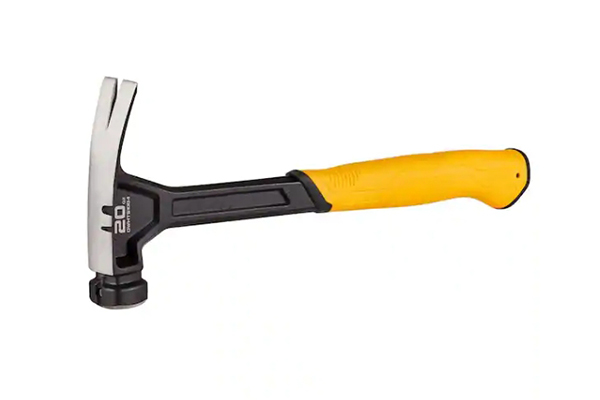When it comes to choosing the right hammer, weight is one of the primary factors to consider. Among the wide variety of hammers on the market, the 20 oz hammer is a popular choice, especially among professionals like carpenters and construction workers. However, for someone who isn’t swinging a hammer daily, this weight might seem excessive. So, is a 20 oz hammer too heavy, or is it the ideal tool for the job? This article delves into the benefits and drawbacks of a 20 oz hammer to help you determine if it’s the right weight for you.
What is a 20 oz Hammer?
A 20 oz hammer refers to the weight of the hammer's head alone, not the entire tool. Typically, this kind of hammer has a steel or fiberglass handle and a head designed for framing or other heavy-duty tasks. The head weight alone makes it suitable for large-scale projects that require a powerful swing, allowing for faster driving of nails and other materials. Hammers of this size usually come with a claw on the opposite side of the head, making it versatile for both hammering and prying tasks.
Advantages of a 20 oz Hammer
1. Power and Efficiency
A 20 oz hammer provides the power needed to drive nails and other fasteners quickly and effectively. The added weight allows for greater momentum, which can make driving nails easier and quicker compared to lighter hammers. This feature is especially valuable in framing, decking, or other types of construction work, where time and efficiency are critical. The extra weight means fewer swings are required to drive each nail, reducing fatigue over the long term.
2. Durability and Reliability
20 oz hammers are often built for heavy-duty use, meaning they are usually more durable and reliable than lighter hammers. This makes them suitable for intense work environments where tools need to withstand frequent and rugged use. These hammers are typically made from high-quality steel, fiberglass, or other sturdy materials that resist wear and breakage.
3. Versatility
Due to its balanced weight and strength, a 20 oz hammer is versatile enough to be used for a range of tasks. While heavier than the average homeowner might typically choose, it can be used for both light-duty repairs and heavy-duty construction work. Many professionals find it to be a perfect middle ground, offering enough power without being overly cumbersome.
Disadvantages of a 20 oz Hammer
1. Risk of Fatigue and Strain
For those who don’t use a hammer frequently, a 20 oz hammer might cause arm and shoulder fatigue after extended use. The weight, while beneficial for power, can put extra strain on muscles, especially if the user lacks experience or muscle endurance. For someone working on a large project without much break time, the added weight can make work more tiring compared to using a lighter hammer.
2. Potential Overkill for Light Projects
If the main use for a hammer is small repairs, hanging pictures, or light carpentry around the house, a 20 oz hammer might be more than necessary. Lighter hammers (10-16 oz) are generally easier to control and manage for smaller tasks, which don’t require the driving power of a heavier hammer. In these cases, the added weight can become cumbersome rather than helpful, making it challenging to perform precision work.
3. Higher Cost
Often, heavier hammers like the 20 oz model are built with higher-grade materials to withstand the extra force required for heavy-duty tasks. As a result, they can come at a higher price point. While this may not be a concern for professionals who rely on their tools every day, for a casual user, the additional cost might not be justified, especially if the hammer won’t be used frequently.
Who Should Use a 20 oz Hammer?
The suitability of a 20 oz hammer largely depends on the type and frequency of work. Here’s a quick guide:
- Professional Carpenters and Construction Workers: If you’re swinging a hammer daily and need efficiency in driving nails, a 20 oz hammer might be ideal. The weight allows for maximum impact with minimal effort, reducing the number of swings needed.
- DIY Enthusiasts and Homeowners: If your projects mainly involve light-duty work, like hanging pictures, furniture assembly, or minor repairs, a lighter hammer (closer to 16 oz) might be a better fit. However, if you often undertake more intensive DIY projects, such as building decks or fences, the added weight of a 20 oz hammer could come in handy.
- Occasional Users: For those who only occasionally need a hammer, the 20 oz may feel too heavy and unwieldy. A lighter hammer is likely to be more comfortable and manageable.
Conclusion: Is a 20 oz Hammer Too Heavy?
In short, a 20 oz hammer is not too heavy if your tasks require heavy-duty performance, and quick driving power, and you’re accustomed to its weight. For professionals, the benefits of power and efficiency outweigh the drawbacks of potential fatigue. However, for lighter tasks and occasional use, a lighter hammer is more suitable.
Ultimately, the decision should be based on the specific needs and frequency of use. A 20 oz hammer is a versatile and powerful tool for those who need it, but for many, lighter options may be more practical.
Post time: 10-25-2024






